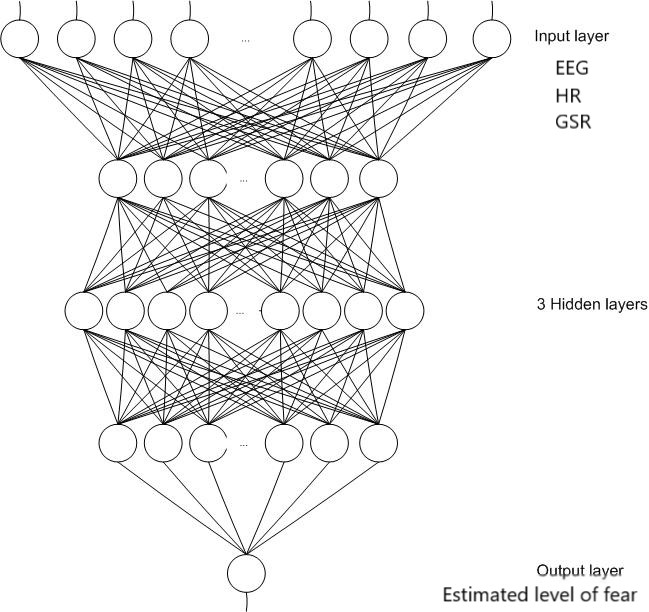SAFE-VR
System for Ameliorating Phobias based on Exposure to Virtual Reality
Results
In order to automatically adapt the levels of the game based on the player’s physiological data, we trained two neural networks (a shallow and a deep one), having as inputs the patient’s biophysical signals and as output, the perceived level of fear (SUD) on different scales. The classification accuracy in both networks is presented in Table 1.

Download the datasets for all 4 users
Both networks had on the input layer a number of 71 neurons, corresponding to the EEG log-normalized powers in the alpha, beta and theta ranges for each of the 16 channels, the ratio of the theta to the beta powers for each of the 16 electrode positions, differences between the right and left power activations in the pre-frontal (PFaD), frontal (FaD) and fronto-central (FCaD) lobes for the alpha range, beta (bDB) and theta/beta (tbDB) differences from the baseline, GSR and HR values. The output layer had only one neuron, corresponding to the perceived level of fear, on a 2, 4 and 11 choices scale.
For the 11-choices-scale, 0 corresponded to complete relaxation, values from 1-3 to small levels of fear, from 4-7 to medium levels of fear and 8-10 to high anxiety. For the 4-choices-scale, the previous scale values have been grouped together, so that finally 0 corresponded to complete relaxation, 1 to small, 2 to medium, 3 to high level of fear. On the 2-choices-scale, the 4-choices-scale values have been also grouped together, in 0 (for the first two levels, meaning relaxation) and 1 (for the third and fourth levels, meaning fear) values. This grouping has been done in order to improve categorization and classification in the neural networks.
Classification results for User 1
Precision, recall, f1-score and support values for the test set
2-choices-scale
4-choices-scale
11-choices-scale
Classification results for User 2
Precision, recall, f1-score and support values for the test set
2-choices-scale
4-choices-scale
11-choices-scale
Classification results for User 3
Precision, recall, f1-score and support values for the test set
2-choices-scale
4-choices-scale
11-choices-scale
Classification results for User 4
Precision, recall, f1-score and support values for the test set
2-choices-scale
4-choices-scale
11-choices-scale
Download the datasets for all 4 users
Another objective that we pursued in our research was to observe how the virtual training sessions affected in-vivo exposure to heights in the post-treatment phase of the experiment. We considered as fear indicators a negative value of the PFaD parameter - mapped to alpha lateralization (high alpha activation in the right prefrontal lobe, corresponding to low alpha power), a large value of bDB (increased value of the beta power compared to the baseline tests), high GSR and HR values.
For each user, we run an ANOVA test to see the significant differences in the post-treatment phase, compared to pre-treatment. There are improvements for almost all the parameters, although not all of them are statistically significant at alpha=0.05.
Table 2 presents the average values for the PFaD, bDB, GSR, HR and SUD parameters in the pre- and post-treatment phases. The statistically significant improvements are specified in the corresponding cells.